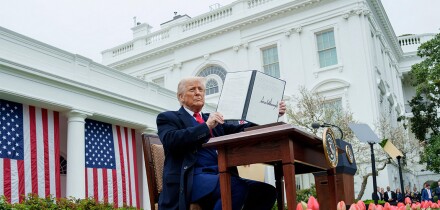For the investor or hedger accustomed to the risk characteristics of developed markets, emerging markets may appear at times confusing, excessively risky, or may seem to offer easy money. Understanding the risks described by the implied volatility surfaces of emerging market currencies can help one to more realistically quantify the expected mean variance characteristics of these markets. There are two related phenomena that explain most of the generalized shape of emerging market volatility surfaces for free floating currencies: interest rate differentials and skewness.
The Volatility Surface
The Black-Scholes-Merton pricing formula (BSM) is a widely used yardstick allowing traders to express option prices in terms of implied volatility rather than premium and to estimate the value of non-traded options. BSM assumes a flat and fixed volatility surface, i.e., there is a single constant implied volatility for all strikes and all maturities. A three-month at-the-money option is assumed to trade at the same implied volatility as a five-year 10-delta option, and these volatilities are assumed to be nonstochastic. In reality, asset price movements are not distributed perfectly normally as assumed by the model and implied volatilities change over time. To be able to trade options using BSM implied volatility--an easier task, since volatilities do not change nearly as much as the underlying option prices--traders adjust the implied volatility for each option, resulting in a volatility surface. The three dimensions are implied volatility, strike and maturity.
The Emerging Market Volatility Surface
Frequency distributions with central tendencies can be characterized by four moments: mean, variance (the average squared deviation from the mean, the square root of which is standard deviation), skewness (the average cubed deviation from the mean scaled by standard deviation) and kurtosis (the average deviation from the mean to the fourth power scaled by standard deviation). Skewness describes the degree of asymmetry around the mean. Kurtosis describes the amount that both tails of the distribution differ from the normal, also termed flatness or peakedness. As taught in many option books, the frequency distributions of changes in most asset prices have fatter tails than the normal distribution; these are called leptokurtic (a distribution with thin tails, virtually unobserved in the financial world, is called platykurtic). But, for most emerging market currencies, as for most equities generally, skewness is much more important than kurtosis. The asymmetry of risks generally results in one fat tail and one thin tail (the fat tail being on the side of depreciation of the asset). In addition to being skewed, emerging market currency volatility curves are usually upward sloping, i.e. the level of implied volatility rises as maturity increases. Both of these phenomena--skewness and an upward-sloping volatility curve--can be attributed to interest rate differentials.
Correlation Between Interest Rate
Differentials & Skewness
Interest rates of emerging market currencies are generally well above those of the developed economies; indeed, one could almost define emerging markets this way. There are several possible explanations for this phenomenon: large budget deficits incurred in anticipation of higher returns on infrastructure investment; a need to maintain high real rates to attract foreign capital; poor monetary/fiscal restraint due to weak central bank independence and/or populist fiscal policies. Whatever the reason for them, high interest rate differentials tend to eventually result in large carry trade positions, whereby investors (local or foreign) borrow in a low-yielding foreign currency (e.g. dollars or euros) and invest in the high-yielding local currency. This behavior probably results from the fact that most people when valuing an asset assume its spot value will remain constant rather than its future value, and that its most frequent value is its expected value. This generally tends to produce long periods of gradual strengthening of the local currency, as more and more funds flow to it in search of high real returns, and brief periods of sharp weakening, as investors take profit/stop loss en masse. This trend-following behavior forms the basis of the significant skewness observed in almost all high-yield currencies.
Correlation Between Interest Rate
Differentials & Implied Volatility
Due to this carry trade phenomenon, high-yield currencies' implied volatilities also generally increase with maturity. There are several ways of interpreting this. One argument is that the greater the difference between the strike and the spot rate, the greater the likelihood that spot will outperform the forward rate at maturity. This is true unless there is a managed depreciation of the currency. Even in this case, it is rare that the currency is depreciated all the way to the forward rate; rather, a substantial real return to holding the currency is usually targeted to attract foreign capital. Since interest accrues linearly over time but option premiums as expressed by implied volatility rise only with the square root of time, volatilities are adjusted upward with maturity to compensate for the expected risk premium return. In the event that the currency does not outperform its forward rate its likely to depreciate significantly, making the volatility around the region of the strike relatively high. Thus, in the case of currency strength, the straddle will be valuable due to the interest differential, and in the case of currency weakness it is likely to be valuable due to overshooting.
Another apparent factor contributing to the upward sloping curve is local event risk. In general, emerging markets are of course less politically and economically stable than developed markets. The longer one's horizon, the greater the chance that a major negative event, such as a military coup or balance of payments crisis, will occur. It could be argued that higher implied volatilities compensate for this increasing (Poisson-distributed) probability of sudden weakening. Typically, however, this risk is already reflected in an upward sloping interest rate curve (inducing higher implied volatilities for longer maturities), making separate consideration of this point unnecessary.
Combining Implied Volatility & Skewness
A final characteristic of note is the link between interest rate differentials and the skewness curve by maturity. In currency option markets, skewness is typically measured by the difference in implied volatility between a 25-delta call and a 25-delta put, which traders call a risk reversal. By this measure, skewness almost always rises with maturity for high-yield/low-yield currency pairs. This phenomenon is again driven by interest rate differentials: higher interest rates create an upward sloping volatility curve and higher absolute levels of volatility are almost always accompanied by higher risk reversals. This is because higher levels of volatility produce relatively wider strikes on the risk reversal. Since skewness rises (at an increasing rate) as the strike rises from calls to puts, wider strikes mean wider volatility spreads. Even in the absence of an upward sloping volatility curve, skewness still rises with maturity for most high-yield currencies, since high interest rates mean the put strike is increasingly far from spot and skewness.
The well-informed investor or hedger can profit from a sound understanding of the intuition behind the volatility surface. It provides a window on the market's full range of risk expectations, which are not directly observable by other means. Incorporating these implied risk expectations can provide more educated (and hopefully more accurate) estimates of risk/return probabilities.
This week's Learning Curve was written by James Kennan, v.p. at BNP Paribas in New York.






